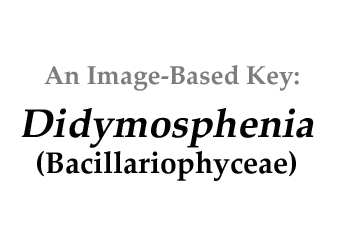|
Home / Diatoms / Pennate / Biraphes / Colonies /Didymosphenia |
||||
 |
|
 |
||
Name derivation: |
||||
|
Greek Didym meaning double or two-fold; sphenia meaning a small wedge or a solid of three un-equal dimensions. |
||||
Classification: |
||||
Didymosphenia M. Schmidt in A. Schmidt 1899; 6 of 27 species descriptions are currently accepted taxonomically (Guiry and guiry 2014).Order Cymbellales; FamilyGomphonemataceae |
||||
Morphology: |
||||
|
Large colonial cells that form a branched stalk of mucilage. valves are rounded at the pole not attached to the mucilage stalk with an enlarged middle. Cells have a straight central raphe in valve view and are ornamented with small punctae that form striations radiating outward from the center. Common name: "rocksnot". Recent appearance in Canadian freshwater streams, both just to the east of the Rocky Mountains (British Columbia and Alberta) and in Quebec and New Brunsick in the maritime province area, has led to speculation that global warming has contributed to its proliferation, and that it is native and not introduced. It has been recorded previously in historical reports from 1896 and 1910 (Lavery M. 2014), and reported in CBC News 28Feb14 7:53 AM Atlantic Time. Thanks to University of New Hampshire Prof. Larry Harris for the report. |
||||
Similar genera: |
||||
|
Similiar to Gomphonema but is distinguished by larger cell size and different pore structure. Striations near the center of the cell are branched in Didymosphenia, but unbranched in Gomphonema. |
||||
Habitat: |
||||
|
Form large macroscopic colonies by attaching to rocks and other substrate with the mucilage stalks. Found in freshwater. Referred to “affectionately” as “rock snot” by state agencies in the USA. |
||||
References: |
||||
|
Guiry, M.D., and G.M. Guiry 2014. AlgaeBase. World-wide electronic publication, National University of Ireland, Galway. http://www.algaebase.org; searched on 04 March 2014. Lavery, M. 2014. [Citation to be added when found]. Round, F. E., Crawford, R. M., Mann, D. G. 1990. The Diatoms. Cambridge University Press. New York, NY. Schmidt, M. 1899. Plates 213-216. In: Atlas der Diatomaceenkunde. (Schmidt, A. Eds) Leipzig: R. Reisland. |
||||





